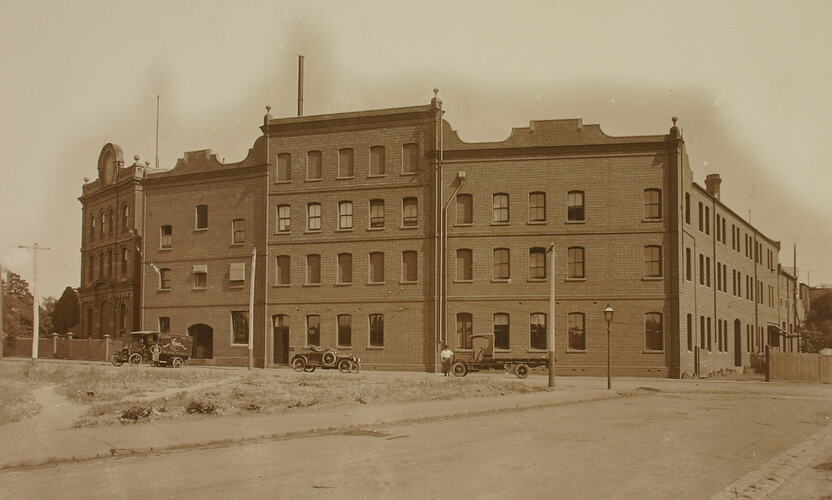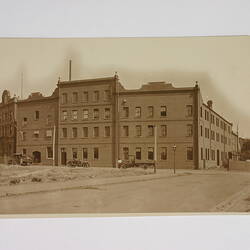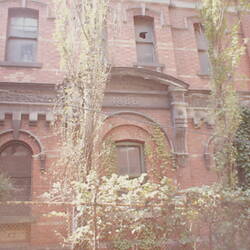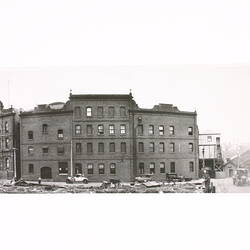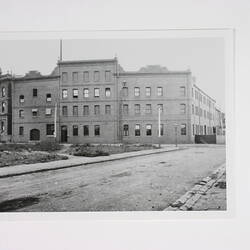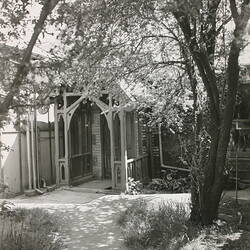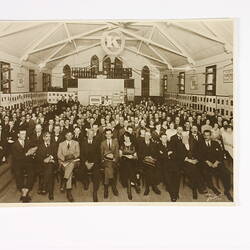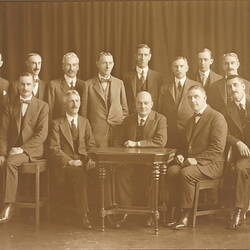The Baker and Rouse Collection documents Melbourne's early photographic industry, tracing the history of the Austral Plate Company and the Baker & Rouse Australia Laboratory.
Thomas Baker
Thomas Baker was a significant figure in the foundation of the Australian photographic industry. In 1884, at thirty years of age, he established a highly successful photographic manufacturing business in Melbourne, which became Australia's biggest provider of photographic material before merging with Kodak in 1908. Baker remained closely involved with the new business, acting as joint Managing Director of Kodak until the end of his life. As successful entrepreneur and then company executive, Baker helped influence how Australians engaged with photography in the late nineteenth and early twentieth century - a boom period when photography was becoming increasingly popular and accessible to the ordinary person.
Baker was born in Somerset, England on 23 June 1854 to Charles Baker, blacksmith, and his wife Ann, née Beaton. The family immigrated to Australia in 1865 and took up residence in Adelaide. Baker worked with his father as a blacksmith, wheelwright and coachbuilder. He then trained as a pharmaceutical chemist, and from 1876 to 1881 worked as a registered chemist in Maryborough, Queensland. On 26 January 1877 at St Paul's Church of England in Maryborough, he married Alice Shaw (1855-1935), the daughter of William Edward Shaw, the postmaster at Raymond Terrace in New South Wales, and his wife Emma, née Coombe.
The Austral Plate Company
Thomas and Alice Baker moved to Melbourne in 1881. Here Baker matriculated in six subjects, and from 1882 to 1883, went on to study medicine at the University of Melbourne. However, he did not finish the degree. Instead, taking advantage of his chemistry expertise, he experimented with making photographic 'dry plates' and in 1884 he established the Austral Plate Company to commercially manufacture these plates. Baker was one of the earliest Australian manufacturers of dry plates, which were developed in the late 1870s. These superseded the 'wet plate' photographic process which was complex, cumbersome, and restricted photography to professionals and educated amateurs, usually with a talent for chemistry.
The Baker's Abbotsford property, located by the Yarra River and known as 'Yarra Grange', was the site of the photographic plate laboratory and factory. Between 1885 and 1891 the company also operated a retail outlet at 190 Russell Street in the city. According to legend, with the aid of his wife Alice and her sister Eleanor, Thomas Baker manufactured plates at night, which they sold by day.
Baker and Rouse Australia Laboratory
In 1887 Baker formed a partnership with John J ('JJ') Rouse. JJ Rouse developed a network of retail outlets around Australia while Baker continued to improve the products. Rouse was outgoing and well suited to the task of promoting the business. His skills in retailing complemented Baker's talents for chemistry and manufacturing, and quiet personality. Around this time the Austral Plate Company changed its name to Thomas Baker and Company Laboratory, then in 1894 another name change occurred, creating Baker and Rouse Australia Laboratory, which reflected the success of the partnership. In 1896 the name was changed again to Baker and Rouse Pty Ltd.
Kodak Australasia Pty Ltd
In 1908 Baker and Rouse's highly successful business merged with Eastman Kodak. The resulting enterprise, Australian Kodak Limited, became Kodak (Australasia) Limited in 1911, then changed again to Kodak (Australasia) Pty Ltd in 1920. After the Baker and Rouse - Kodak merger, Thomas Baker and John Rouse both retained joint Managing Director roles at Kodak, leading the company to great success until the end of their lives. Kodak has been a significant manufacturer and distributor of photographic products in Australia, and an important educator in regard to the practice of photography.
Thomas Baker's Legacy
Not content to dedicate his life to photography only, Thomas Baker was also involved in munitions manufacture during World War I, and he invested money prospecting for oil in Australia and New Zealand. Baker was a significant philanthropist who contributed considerable funds towards medical research in Melbourne. In keeping with his early training as a chemist, Baker, along with his wife Alice and his sister-in-law Eleanor Shaw, donated funds in 1913 for cancer research and in 1922 financed a biochemistry department at the Alfred Hospital, named the Baker Institute. Through their wills, the three benefactors also established a trust for the ongoing funding of medical research at the Baker Institute. The Bakers also gave funds to other charities, including the Red Cross and the Limbless Soldiers. Thomas Baker was active in community leadership in other ways too, including being president of the Melbourne Rotary Club.
On 4 December 1928, after many decades in the photographic business, 74 year old Thomas Baker suddenly died. Entrepreneur, scientist, industrialist and philanthropist, Thomas Baker's legacy to Australian photography now lives on in the Baker and Rouse Collection and the Kodak Heritage Collection, both held at Museum Victoria.
References
A History of Photographic Manufacture in Australia - From Abbotsford to Coburg, unpublished manuscript, Kodak Heritage Collection, Museum Victoria, pp.2-4, 16.
Beale, N, (no date). History of Kodak, Kodak Heritage Collection, Museum Victoria.
City of Yarra, 'Former Kodak Factory', http://www.yarracity.vic.gov.au/rates/Arts%20&%20Culture/Plaque%20Kodak.asp accessed 28 September 2009.
Davies, A & Stanbury, P (1986). The Mechanical Eye in Australia Photography 1841-1900, Oxford University Press, Melbourne, p.54.
De Serville, P (1979). 'Thomas Baker (1854 - 1928) Biographical Entry', Australian Dictionary of Biography, http://adbonline.anu.edu.au/biogs/A070156b.htm accessed 28 September 2009.
Leggio, A (2006). 'A History of Australia's Kodak Manufacturing Plant', Conservation of Paper, Books and Photographic Materials Symposium Proceedings, Australian Institute for the Conservation of Cultural Material [ICCM], Wellington, New Zealand, 19-21 April 2006, pp.147-158.
Lowe, T (1974). The Thomas Baker, Alice Baker and Eleanor Shaw Medical Research Institute: The First Fifty Years, Trustees of the Institute, Melbourne, pp.9-10.
Noye, RJ 'Bob'. 'Philip J Marchant', Photohistory SA, http://www.artgallery.sa.gov.au/noye/Photogs/March_pj.htm accessed 24 September 2009.
Rosenblum, Naomi (1997). A World History of Photography, Abbeville Press, New York, p.442.
University of Melbourne eScholarship Research Centure, (Australian Science Archive Project), 'Thomas Baker Biographical Entry', Bright Sparcs, http://www.asap.unimelb.edu.au/bsparcs/biogs/P000034b.htm accessed 28 September 2009.
University of Melbourne eScholarship Research Centure, (Australian Science Archive Project), 'Thomas Baker and Company Laboratory (1887 - 1894)', Corporate Entry, Australian Science at Work, http://www.austehc.unimelb.edu.au/asaw/biogs/A000509b.htm accessed 28 September 2009.
University of Melbourne eScholarship Research Centure, (Australian Science Archive Project), 'Kodak (Australasia) Proprietary Limited (2000 - )', Corporate Entry, Australian Science at Work http://www.austehc.unimelb.edu.au/asaw/biogs/A000229b.htm#related accessed 28 September 2009.
More Information
-
Keywords
-
Authors
-
Article types
